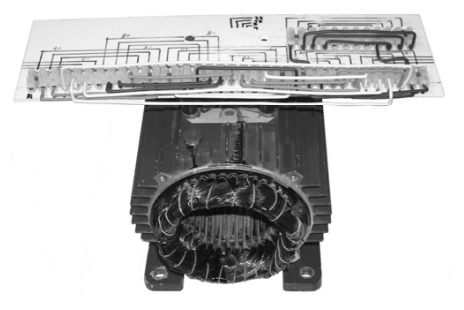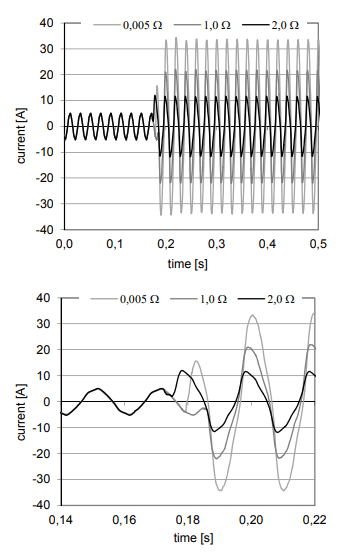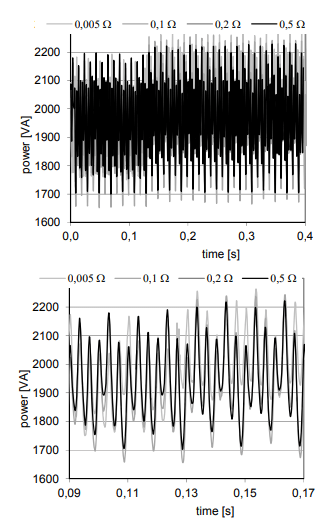Published by Maciej ANTAL, Wrocław University of Science and Technology, Department of Electrical Machines, Drives and Measurements
Abstract. A physical model of a squirrel-cage induction drive, allowing to stimulate coil short circuits in the front part of the motor, was used to investigate the phenomena accompanying short circuits. Assuming that a short circuit occurs during motor operation, phase stator current time waveforms, current in short-circuited coils and instant power were measured. Various cases of coil short circuits were analysed. The influence of the resistance value of the short-circuit point and short-circuit magnitude on electromechanical phenomena occurring during a stator winding short circuit was investigated.
Streszczenie. Za pomocą modelu fizycznego klatkowego silnika indukcyjnego umożliwiającego symulowanie zwarć zwojowych w strefie czołowej silnika, zbadano przebieg zjawisk towarzyszących zwarciom. Zakładając, że zwarcie następuje w czasie pracy silnika, zmierzono przebiegi czasowe prądów fazowych stojana, prądu w zwojach zwartych oraz mocy chwilowej. Rozpatrzono różne przypadki zwarć zwojowych. Zbadano wpływ wartości rezystancji punktu zwarcia oraz rozmiaru zwarcia na przebieg zjawisk elektromechanicznych podczas zwarcia uzwojeń stojana maszyny. (Zwarcia zwojowe w uzwojeniu stojana klatkowego silnika indukcyjnego).
Keywords: induction motor, stator winding faults, measurements, coils short circuits
Słowa kluczowe: silnik indukcyjny, uszkodzenia uzwojenia stojana, pomiary, zwarcia zwojowe
Introduction
Electrical faults of stator windings in induction motors are the second most frequently occurring faults after bearing defects [1, 2]. The reason for this fault is usually winding insulation degradation resulting from difficult operating conditions, or a long exploitation time. The possible faults encompass winding, coil and interphase short circuits, as well as earth faults. The detection and diagnostics of such faults has been extensively described in literature [e.g. 3, 4, 5, 6, 7]. The most considerable interest was aroused by winding short circuits because in their initial phase they are very hard to detect, and their local impact is extremely destructive. Interesting results were obtained from the field circuit analysis of faulty induction motors [8, 9]. Current density in short-circuited turns may reach very high values (even up to 75 A/mm2 with negligible resistance of the short circuit point), which means the risk of quick burning out of these turns. This may result in switching off the shorted turns or interrupting the phase. Long-term short circuits, which are possible when the resistance of a short circuit point is high, increase the temperature in the short-circuit area and consequently lead to insulation overheating and short circuit growth.
Each, even very small, electric fault of motor winding is easily observable in the three-phase instantaneous power waveform. During a fault, the variable component with a frequency of 100Hz, whose amplitude is the measure of fault size, becomes more evident.
Stator winding faults result not only in the disturbances of torque, speed, power or current waveforms, but they are also the reason for motor overheating. Excessive heating refers to stator winding and also other key motor elements: the rotor cage and stator core. It is confirmed by the heating curves of these elements determined for a motor with four shorted stator windings [10]. The investigation of 30-second short circuits of larger size windings showed that both the temperature increase in stator windings and the rotor cage grow nonlinearly along with the number of shorted turns of stator phase winding. The increase in the defect is followed by a faster winding temperature gain.
Hence, it seems reasonable to verify the phenomena accompanying coils short circuits using a physical model. Such a model allows to observe the consequences of short circuits in real power supply conditions.
Tested motor
The experimental tests were conducted at an experimental setup for electromechanical research on low-power machines. The measurement apparatus installed at the setup allows to record both static and dynamic electrical values (current, voltage, power) and also mechanical ones (torque, speed).
The research was conducted on a specially rewound motor allowing to model coils short circuits in its front part. The beginnings and ends of particular stator winding coils were installed on the connector board (Fig.1). In addition to this, one of the coils was divided into a few groups of windings. The thus prepared physical model allows to simulate short circuits of whole coils and a few windings of one coil. A short circuit was induced by a contactor being a part of the shorted circuit. Converter clamps enabled recording currents in shorted turns.

Research results
Using the above described experimental setup and the machine model, the investigations of coils short circuits in a small power motor were conducted. The influence of the resistance value of the short circuit point and the fault size on the phenomena accompanying short circuits was analysed. During the research, the values of voltage, currents, torque and machine speed were recorded. In the monitoring of machine condition the most important factor is observing phase-currents and instantaneous power, thus a harmonic analysis of their waveforms was conducted. The waveforms currents in shorted turns are also presented as their value provides the information on heating and a possible fault development.


Figures 2 – 7 present the results of research on the influence of the value of short circuit point resistance on the phenomena accompanying these short circuits. In the investigations, the most extreme short circuit states which could be obtained with the used model were selected: four shorted turns and the whole shorted coil (51 turns). Figures 2 – 4 present the research on the influence of the values of the short circuit resistance point on waveforms in the motor with a single shorted coil, and Figs. 5 – 7 in a motor with four shorted turns.




In the case of a motor with a shorted coil, three recordings were made for shorting resistance values of 0.005; 1 and 2Ω. In the case of a motor with four shorted turns, four recordings were made for shorting resistance values of 0.005; 0,1; 0.2 and 0.5Ω. In both cases the shorting resistance increase decreases disturbances caused by a short circuit. All values of the phase currents of a shorted phase (Figs. 2 and 5), currents in shorted turns (Figs. 3 and 6), and also the mean value of instantaneous power input to the motor (Figs. 4 and 7). When a fault is small, as is the case of four shorted turns, these phenomena are hard to observe in both phase currents (Fig. 5) and power used by the motor (Fig. 7).
Another tested value was the influence of a stator winding fault size on the phenomena existing in a machine by simulating a short circuit of four, twelve, twenty two and fifty one turns (whole coil) with a resistance of 0.005Ω.



Global values, such as current in a shorted phase (Fig. 8) or power used by a motor (Fig. 10) in the steady state after the fault clearly grow along with fault increase. However, such an increased could not be observed in the waveforms of shorted circuit currents (Fig. 9).
Due to the fact that in the research the same resistance value of the short circuit point was used for all analysed shorted circuits, its ratio to particular resistance values in shorted turns varies. This is why currents flowing through shorted turns achieve various values and are not proportional to the fault size.
Summary
The presented research results confirm the field circuit calculations conducted earlier and, above all, they prove that as a result of coils short circuits truly dangerous phenomena (current in shorted turns) are hardly observable and or even invisible in the waveforms of recorded, external physical values. However, it is possible to observe the asymmetry of stator currents, significant pulsations of instantaneous power and incremental increase in the average value of instantaneous power at the moment when a short circuit occurs. The detection of coils short circuits is particularly desirable at the stage before short circuits cause significant damage to windings. A coils short circuit may last for some time without extending and thus damaging new turns when it encompasses a small number of turns or the resistance value of the short circuit point is significant in comparison with the resistance value of shorted turns.
To sum up the results of the research on coils short circuits, one can conclude that they remain nearly invisible in phase current and instantaneous power waveforms. The earlier research on the influence of machine load on fault detection indicate that a small coils short circuit seems easier to detect when the machine is in a neutral gear position. Short circuits encompassing a larger number of turns are easier to detect. Regardless of size, coils short circuits are signalled in instantaneous power time waveforms. In the waveform the constant and variable components with double current and voltage frequencies dominate. Both of these components grow incrementally as a result of a coils short circuit and this change is noticeable even when the number of shorted turns is small. The growth of instantaneous power is also highly dependent on the resistance value of the short circuit point. The deformation of supply voltages does not have any influence on the detectivity of coils short circuits.
REFERENCES
[1] Pietrowski W., Górny K., Detection of inter-turn short-circuit at start-up of induction machine based on torque analysis, Open Physics, Volume 15, Issue 1, 29 Dec 2017
[2] Sahraoui M., Zouzou S. E., Guedidi S., A new method to detect inter-turn short-circuit in induction motors, The XIX International Conference on Electrical Machines – ICEM 2010, 2010
[3] Wolkiewicz M., Tarchała G., Orłowska-Kowalska T., Kowalski Cz., Online stator interturn short circuits monitoring in the DFOC induction-motor drive. IEEE Transactions on Industrial Electronics. 2016, vol. 63, nr 4, s. 2517-2528
[4] M’hamed Drif, Antonio J. Marques Cardoso, Stator Fault Diagnostics in Squirrel Cage Three-Phase Induction Motor Drives Using the Instantaneous Active and Reactive Power Signature Analyses, IEEE Transactions on Industrial Informatics, 2014, vol. 10, Issue: 2
[5] Maryam Eftekhari, Mehdi Moallem, Saeed Sadri, Online Detection of Induction Motor’s Stator Winding Short-Circuit Faults, IEEE Systems Journal. 2014, vol. 8, Issue: 4
[6] Rama Devi N., Siva Sarma D. V. S. S., Ramana Rao P. V., Diagnosis and classification of stator winding insulation faults on a three-phase induction motor using wavelet and MNN, IEEE Transactions on Dielectrics and Electrical Insulation, 2016, vol. 23, Issue: 5
[7] Dorrell D. G., Makhoba K., Detection of Inter-Turn Stator Faults in Induction Motors Using Short-Term Averaging of Forward and Backward Rotating Stator Current Phasors for Fast Prognostics, IEEE Transactions on Magnetics, 2017, vol. 53, Issue: 11
[8] Antal M., Antal L., Zawilak J., Badania uszkodzeń uzwojenia stojana klatkowego silnika indukcyjnego, Maszyny Elektryczne Zeszyty Problemowe, 2007, nr 76, 83-88
[9] Fireteanu V., Constantin A-I., Romary R., Pusca R., Ait-Amar S., Finite element investigation of the short-circuit fault in the stator winding of induction motors and harmonics of the neighboring magnetic field, 9th IEEE International Symposium on Diagnostics for Electric Machines, Power Electronics and Drives, 2013
[10] Antal L., Gwoździewicz M., Marciniak T., Antal M., Badania skutków cieplnych zwarć zwojowych w uzwojeniach stojana silnika indukcyjnego, Prace Naukowe Instytutu Maszyn, Napędów i Pomiarów Elektrycznych Politechniki Wrocławskiej. Studia i Materiały, (2012), nr 32, 316-324
Author: Maciej Antal, PhD Eng. Wrocław University of Science and Technology, Department of Electrical Machines, Drives and Measurements, Smoluchowskiego 19, 50-372 Wrocław, Poland, E-mail: maciej.antal@pwr.edu.pl
Source & Publisher Item Identifier: PRZEGLĄD ELEKTROTECHNICZNY, ISSN 0033-2097, R. 97 NR 1/2021. doi:10.15199/48.2021.01.15